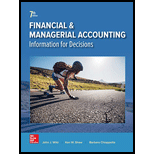
Concept explainers
(1)
To prepare: Direct material budget for September, October.
(1)
Explanation of Solution
Given,
September,
Production units are 4,600.
Raw material required per unit 2 pounds.
Opening raw material is 3,680 units.
October,
Production units are 6,200.
Raw material required per unit 2 pounds.
November,
Production units are 5,800 units.
| Direct Material Budget | ||
| Particulars | September | October |
| Production (units) | 4,600 | 6,200 |
| Raw material required (pounds) (working note) | 9,200 | 12,400 |
| Add: Ending raw material (working note) | 4,960 | 4,640 |
| Less: Opening raw material | 3,680 | 4,960 |
| Total material required (pounds) [A] | 10,480 | 12,080 |
| Purchase cost [B] | 4 | 4 |
| Total Purchase Cost ($) | 49,920 | 48,320 |
| Table (1) | ||
Working notes:
Formula to compute raw material required,
For September,
Substitute 4,600 units for production and 2 pounds for raw material required per unit.
For October,
Substitute 6,200 units for production and 2 pounds for raw material required per unit.
November’s material requirement,
Substitute 5,800 for production and 2 pounds for raw material required per unit.
Formula to compute ending raw material,
For September,
Substitute 12,400 for third October’s material requirement,
For October,
Substitute 11,600 for November’s material requirement,
(2)
To prepare: Direct labor budget for September, October.
(2)
Explanation of Solution
Given,
September,
Production is 4,600 units.
Labor rate per hour is $16.
Labor hours per unit are 0.8.
October,
Production is 6,200 units.
Labor rate per hour is $16.
Labor hours per unit are 0.8.
| Direct Labor Budget | ||
| Particulars | September | October |
| Production(units) | 4,600 | 6,200 |
| Hours required per unit | 0.8 | 0.8 |
| Total hours required | 3,680 | 4,960 |
| Labor rate per hour | 16 | 16 |
| Total labor cost($)[working note] | 58,880 | 79,360 |
| Table (2) | ||
Working note:
Formula to compute total labor cost,
For September,
Substitute 3,680 hours for total hours required and $16 for labor rate per hour.
For October,
Substitute 4,960 hours for total hours required and $16 for labor rate per hour.
(3)
To prepare: Factory
(3)
Explanation of Solution
| Factory Overhead Budget | ||
| Particulars | September | October |
| Total labor hours required (From part 2) | 3,680 | 4,960 |
| Application rate per labor hour ($) | 2 | 2 |
| Variable overheads ($) | 7,360 | 9,920 |
| Add: Fixed overheads (given) | 10,000 | 10,000 |
| Total factory overheads | 17,360 | 19,920 |
| Table (3) | ||
Hence, Direct material budget of September is $49,920, October.$48,320.
Direct labor budget of September is $58,880, October.$79,360.
Factory Overhead Budget of September is $17,360, October.$19,920.
Want to see more full solutions like this?
Chapter 20 Solutions
Financial and Managerial Accounting
- Please explain the correct approach for solving this general accounting question.arrow_forwardI need the correct answer to this general accounting problem using the standard accounting approach.arrow_forwardI am searching for the correct answer to this general accounting problem with proper accounting rules.arrow_forward

 AccountingAccountingISBN:9781337272094Author:WARREN, Carl S., Reeve, James M., Duchac, Jonathan E.Publisher:Cengage Learning,
AccountingAccountingISBN:9781337272094Author:WARREN, Carl S., Reeve, James M., Duchac, Jonathan E.Publisher:Cengage Learning, Accounting Information SystemsAccountingISBN:9781337619202Author:Hall, James A.Publisher:Cengage Learning,
Accounting Information SystemsAccountingISBN:9781337619202Author:Hall, James A.Publisher:Cengage Learning, Horngren's Cost Accounting: A Managerial Emphasis...AccountingISBN:9780134475585Author:Srikant M. Datar, Madhav V. RajanPublisher:PEARSON
Horngren's Cost Accounting: A Managerial Emphasis...AccountingISBN:9780134475585Author:Srikant M. Datar, Madhav V. RajanPublisher:PEARSON Intermediate AccountingAccountingISBN:9781259722660Author:J. David Spiceland, Mark W. Nelson, Wayne M ThomasPublisher:McGraw-Hill Education
Intermediate AccountingAccountingISBN:9781259722660Author:J. David Spiceland, Mark W. Nelson, Wayne M ThomasPublisher:McGraw-Hill Education Financial and Managerial AccountingAccountingISBN:9781259726705Author:John J Wild, Ken W. Shaw, Barbara Chiappetta Fundamental Accounting PrinciplesPublisher:McGraw-Hill Education
Financial and Managerial AccountingAccountingISBN:9781259726705Author:John J Wild, Ken W. Shaw, Barbara Chiappetta Fundamental Accounting PrinciplesPublisher:McGraw-Hill Education





